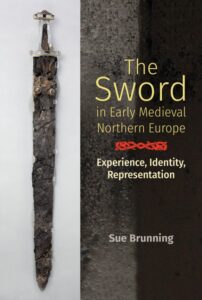Sue Brunning
The Sword in Early Medieval Northern Europe: Experience, Identity, Representation
(The Boydell Press, 2019) 213 pp. $99.00

Sue Brunning’s book belongs to a long line of research regarding early medieval swords. However, instead of staying within the well-established boundaries of this type of scholarship, the author moves away from typologies and discussions of origin. Instead, the sword is treated as an organic part of the sword-owner’s life, and an object whose depiction in material culture and written sources was molded by the experiences that it shaped.
The greatest strength of the book is its truly interdisciplinary approach and methodology, which combines material culture, iconography, and literature sources in order to investigate its subject. Whereas similar multidisciplinary approaches are increasing in popularity in recent years in arms and armour studies, they are more common in the study of later periods where the different types of sources overlap chronologically, lending themselves to this type of methodologies. Brunning acknowledges that the sources used in the book do not always overlap chronologically or geographically, however, their comparison helps in creating and exploring the multifaceted mosaic of the period in question using the sword as a focal point. The bibliographical research in each chapter is exhaustive, which is impressive considering the multidisciplinary nature of the work, and providing excellent support for further study on related subjects.
The structure of the book is based on the three different types of evidence: imagery, archaeology, and text. These axes allow specific discussion of the sword in different contexts, acknowledging the various forms it inhabited in the examined chronological and geographical boundaries. However, instead of completely isolating these elements, the author links and compares them, engaging in a discourse that allows the contextualization of the sword not only in relation to the aforementioned axes but in general to a whole socio-military reality. Additionally, the intellectual processes and symbolism related to the sword in early modern Europe are addressed, discussing subjects that are often overlooked in the study of arms and armour.
The discussion is organised into four chapters, with the addition of an introduction that lays out the methodology and approach that follows, a postscript, an appendix of the images an swords referenced in the text, a bibliography, and an index. The first chapter is dedicated to iconographical evidence that includes swords belonging to the geographical and chronological boundaries investigated. The form of depicted swords is discussed, but most importantly Brunning addresses the context in which the objects are depicted and particularly the identity of their wielders (based on gender, status, time and space), thus setting up early on a link between the role of the sword and its user, and how this affected its portrayal and importance. The second chapter deals with swords from an archaeological perspective, presenting the context in which swords were found (particularly burial sites) in a comprehensive manner. The different forms of the object and their changes, both during their own ‘lifetime’ as well as over a broader period of time, and the variety in their resting archaeological sites are presented often using the Anglo-Saxon/Scandinavian dipole as a mean of comparison. The first and second chapters include accompanying images that render discussion on iconography and extant examples more comprehensive. The third chapter deals with textual examples of swords. Brunning delves into a linguistic journey regarding words that mean, discuss, or are used with swords. An investigation of the use of the sword in early medieval poetry in Old Norse and Old English, and of their attributed epithets, reveals how people perceived and expressed their thoughts on these objects particularly in regards to their proximity to them. A recurring theme in these three chapters is the consistent use of time and space to compare the discussed media in each case. This approach is understandable, or even necessary, in a subject that primary sources and material culture are often scarce, and the lines regarding origin (as well as agency in the case of artistic production) are blurry.
The fourth chapter, and perhaps the most interesting part of this study, is dedicated to the notion of swords as ‘living’ objects. Swords are discussed through textual and visual examples to link them to the psyche of those that wielded them. Whereas the methodologies and approach in the majority of Brunning’s research are based on established norms within material culture studies, this aspect of the object is largely understudied. Swords become ‘living’ things both because of their physical cycle, as well as their association to particular aspects of their users’ lives. The sword “offered – and endured – an experience of such singular intensity that its sharing fused the wielder and the weapon together, like the intricate core of a pattern-welded sword”. (156)
The triptych upon which the book is based on elucidates the nature of the sword in Anglo-Saxon and Scandinavian thought as something far more than simply an object with a singular function. The sword is highlighted in the context of this research as a symbol of the warrior’s status, and an interconnected and key aspect of their identity. Overall, Brunning has conducted an exhaustive research on an fascinating subject, which is impressive considering the different media discussed. Regardless of being meticulous with the details in the media examined, the author managed to avoid delving into pedantic discussions of themes and types (subjects already discussed in this field of study) but has instead provided a fresh approach and grounds for further research.
Iason-Eleftherios Tzouriadis
The Worshipful Company of Gold and Silver Wyre Drawers, London
[email protected]
